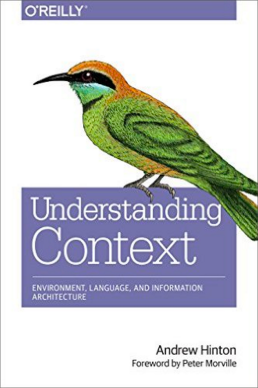Experiences: Service Experiences
UXmatters has published 9 articles on the topic Service Experiences.
Top 3 Trending Articles on Service Experiences
-
Understanding Context: Environment, Language, and Information Architecture
March 9, 2015No CommentsThis is a sample chapter from Andrew Hinton’s new book, Understanding Context: Environment, Language, and Information Architecture, in which he explores the principles and processes that shape and change context for users. Chapter 21, “Narratives and Situations,” is one of the chapters from the book’s final segment on “Composing Context.”
Chapter 21: Narratives and Situations
The Universe is made of stories, not of atoms.—Muriel Rukeyser
People Make Sense Through Stories
 Before composing something new we should understand what is already there. But we’ve already established that there is no stable, persistent “context” to begin with—that it emerges through action. So, how do we understand the current state if it won’t sit still? The key is in studying the experience from the points of view of the agents involved and how they think and behave. Those points of view provide the dynamic landscape—and the principles we derive from it—that puts everything else into perspective. These agents can be individual users, groups of them, organizations, and even digital actors. Let’s begin with how humans work—and how they understand their experience as narrative. Recall our working definition: context is an agent’s understanding of the relationships between the elements of the agent’s environment. Read More
Before composing something new we should understand what is already there. But we’ve already established that there is no stable, persistent “context” to begin with—that it emerges through action. So, how do we understand the current state if it won’t sit still? The key is in studying the experience from the points of view of the agents involved and how they think and behave. Those points of view provide the dynamic landscape—and the principles we derive from it—that puts everything else into perspective. These agents can be individual users, groups of them, organizations, and even digital actors. Let’s begin with how humans work—and how they understand their experience as narrative. Recall our working definition: context is an agent’s understanding of the relationships between the elements of the agent’s environment. Read More -
Calculated Misery: The Dark Side of UX Strategy
February 16, 2015When I talk to companies, customers, and colleagues about UX strategy and the importance of understanding the end-to-end customer experience, I often tell stories about seemingly trivial parts of an experience with a brand that can have huge impacts. Small things can have significant impacts on customer acquisition and loyalty—and companies often overlook or under-prioritize them. For example:
- The process of exchanging a pair of shoes to get the right size may be so cumbersome that you don’t even want to bother with it.
- A meal that you have at a restaurant leaves a bad taste in your mouth—not because it wasn’t delicious, but because the server was inattentive and rude.
- Navigating a company’s interactive voice response (IVR) system to speak to a real person on the phone becomes a test of rage restraint, because it’s so abundantly clear that they want to make it as hard as possible.
-
The Life in Between: A New Model of Customer Engagement for Life Insurance
March 18, 2019Several years ago, our financial advisor and good friend began talking to us about retirement planning, college savings for our infant daughter, and the importance of life insurance. He said, “It’s not cheap, but you need to do it.” He advised us on the company to choose, began the paperwork, and told us how to continue the application process. Of course, I didn’t look forward to taking on the cost or the administrivia of applying for life insurance. “You’ll need to answer questions about your income and health and have physicals,” our friend told us. Nevertheless, there was something oddly fulfilling about applying. Life insurance isn’t a fun topic or process, but it represented a milestone in our lives. With a family, I was ready to think about someone other than myself.
The Emotional Side of Life Insurance
The woman processing our application was perfectly nice and professional. Some of the questions she asked caused some anxiety and made me feel defensive—those about drinking and exercise. Others, I answered proudly—no smoking, good eating. However, I wasn’t prepared for one question: “Are your parents alive or deceased?” My dad had passed away a few months earlier. I felt my renowned ability to contain my emotions start to waiver. She expressed her sympathy and asked the reason. I answered, “pancreatic cancer,” and started crying, then apologized, saying it was still recent so I hadn’t gotten used to talking about it. She was very patient, then we continued with the questions. Read More
All Articles on Service Experiences
- Necessity Is the Mother of Invention: Service-Experience Improvements and the Pandemic
- Is Your User Experience Saving the World?
- Driving Telehealth Success by Creating Trust and Meaningful Interactions
- The Life in Between: A New Model of Customer Engagement for Life Insurance
- Keeping Life Meaningful: Designing the Senior Residence Experience
- Robots Do It Better: Why Users Love Self-Service Technologies
- The Value of a Good Service Experience for School Admissions
- Understanding Context: Environment, Language, and Information Architecture
- Calculated Misery: The Dark Side of UX Strategy
New on UXmatters
- Linking Customer Experience to Business Results for Sustainable Growth
- Using AI to Design Better Mobile-App User Experiences
- Leveraging the Psychology of Color in UX Design for Health and Wellness Apps
- Elevating the User Experience and Fostering Loyalty: Accessible Design for Travel-Booking User Interfaces
- Using Data Analytics to Optimize the In-Store and Online Retail Experience